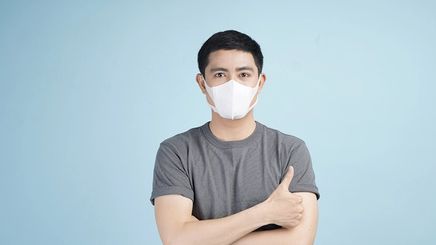
Let’s face it: Maskne, or an acne breakout triggered by wearing a mask, is now a fact of life. You need an extra careful acne care routine to combat it.
According to the Journal of the American Academy of Dermatology (JAAD), is a variant of acne mechanica, previously associated with headgear or PPEs. Just think of it this way: if you get pimples from wearing a helmet or a baseball cap, then you’re pretty much getting maskne the same way — that is, from friction, pressure, heat, moisture, and the blocking of hair follicles with sweat and sebum.
The JAAD refers to the area typically affected by this type of acne as the O-zone. The skin’s natural microbiome is disrupted and modified in mask-wearing. The following acne care routine follows JAAD’s recommendations for preventing and treating this acne type.
Wash Your Face with an Antibacterial Cleanser
Hate to break it to you but wearing a clean mask over a sweaty face doesn’t work. You need to before you wear a mask to make sure your pores aren’t trapping oil and sweat that can lead to breakouts. What you want is a product that cleans, treats, and strengthens skin.
Try POND’S Men Acne Solution Anti-Acne Face Wash, the first facial wash with Lock & Clear technology that helps beat acne in three days. It also contains , which the JAAD recommends for repairing the skin barrier. This acne face wash for men can also help brighten acne marks. Meanwhile, target oil and clogged pores with Master Facial Wash Anti Pimple, which controls oil for up to 8 hours and helps prevent breakouts with an antibacterial agent.
Check Your SPF
The JAAD states that some chemical sunscreens can be comedogenic and may increase skin sensitivity and clog your pores. Make sure your sunscreen is non-comedogenic and wash your face in between face mask changes to prevent occlusion and irritation.
Make Sure Your Mask Fits Well
Your mask should be able to go over your nose without constant adjustment. You should be able to speak comfortably without moving the mask around so much and causing friction. Any kind of constant rubbing can irritate your skin and cause it to break out.
Change Your Mask Every 4 Hours
The Center for Disease Control recommends changing masks every four hours. If you’re active and sweating from working out, being outdoors, or staying in a humid environment, you should replace your mask as soon as it becomes moist. Moisture increases discomfort, which leads to lots of face-touching, and promotes the growth of acne-causing bacteria.
Follow these simple acne care steps for clear and pimple-free skin even under that mask.